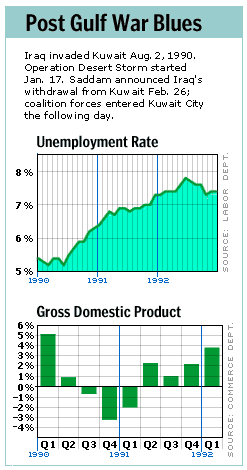This article originally ran Jan. 21. It has been updated.
NEW YORK (CNN/Money) -- When weighing how to approach the war with Iraq, many investors have reckoned that what the market did leading up to and during the 1991 Gulf War provides a good guide. But they may be looking at the wrong playbook.
Buying into the teeth of the Gulf War turned out to be one of the greatest investment opportunities of the last 20 years. Stocks had been sputtering since Iraq invaded Kuwait Aug. 2, 1990, and the S&P 500 had fallen 11 percent on the eve of Operation Desert Storm as investors fretted the United States was in for a protracted war.

The nervousness didn't last long, however, as it quickly became clear that the war was going to go better for the United Nations' forces than anyone had hoped. On Jan. 17, 1991, the first day of Desert Storm, the S&P jumped 3.7 percent. By the time Iraqi forces withdrew from Kuwait City Feb. 26, the S&P had gained 14.8 percent. And at the end of the year it was 31.9 percent higher.
Using that as their guide, investors have bid stocks higher ahead of conflict this time around. In the week before the United States' early-morning missile strike Thursday against Baghdad, the Dow climbed 9.4 percent, the S&P tacked on 8.7 percent and the Nasdaq tacked on 9.2 percent.
So what's the problem with the analogy? Brett Gallagher, head of U.S. equities at Julius Baer Investment Management, points out that, for one thing, market participants heading into 1991 were expecting a more difficult war than the one they got.
"Markets took off because expectations were so much worse than reality," he said. "Now we're expecting that it's going to be nice and easy. Maybe it will, but those expectations are already factored into the market."
Investors may also be confusing the market movement in the Gulf War's wake with what happened in the economy. The received wisdom on Wall Street says that were it not for Iraqi President Saddam Hussein, consumers and businesses would loosen up their purse strings leading to a tremendous economic revival.
Yet although the economy did emerge from recession in early 1991, it wasn't all sweetness and light after that. After contracting 2 percent in the first quarter the economy grew at a measly rate for the rest of the year. And the labor market was stifled for years, with unemployment rising from 6.3 percent at the end of 1990 to a high of 7.8 percent in June 1992. The slow recovery is widely believed to have lost then-President George Bush the 1992 election.
"The reason the recovery was so feeble was you still had these hangover effects from the real estate and banking sectors," said Lehman Brothers chief economist Ethan Harris. "Real estate was still reeling from excess capacity and the whole thrift industry had been decimated by bad loans."
And now? It's a different hangover, but in some ways it feels like the same old headache. This time it's not real estate that has been crushed by overcapacity, but the technology industry. Last week the Fed reported that the tech industry's capacity utilization rate was 61.7 percent in December, down from its 2000 high of 91.2 percent. A world without Saddam Hussein isn't going to make that, or the other lingering excesses from the bubble years, go away.
"People are overweighting geopolitical risk as a factor weighing on the economy," said Goldman Sachs director of U.S. economic research Bill Dudley. "But the balance sheet adjustments set in motion by the stock market's decline are more important. Even with a good outcome in Iraq, it's not going to be a good growth year."
But does a middling economic recovery really mean the market couldn't climb higher on a swift resolution in Iraq? After all, it would at least help ensure that the economy would recover (however slowly) thanks to lower oil prices and the removal of one big geopolitical uncertainty. And, face it, the market sped higher in 1991 despite tepid economic growth.
There's one big difference between now and then, however: price. When the Gulf War began the S&P 500 was trading at around 15 times the trailing year's earnings under generally accepted accounting principles. Now that P/E is around 30.

|

